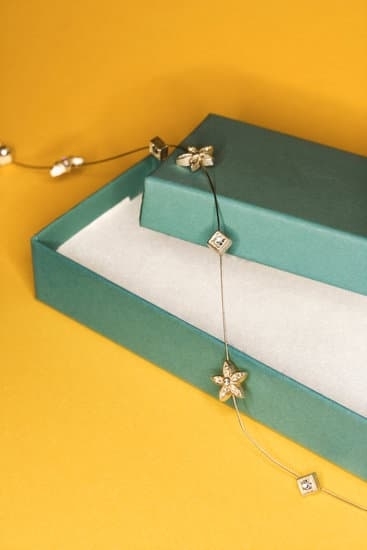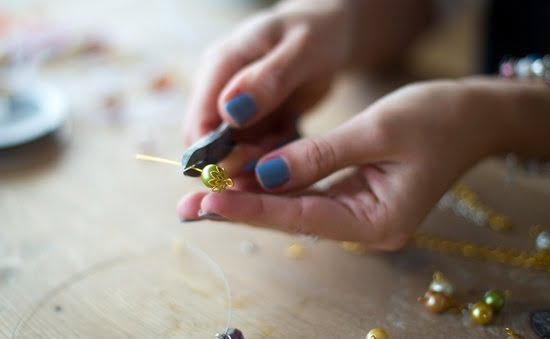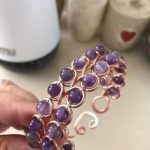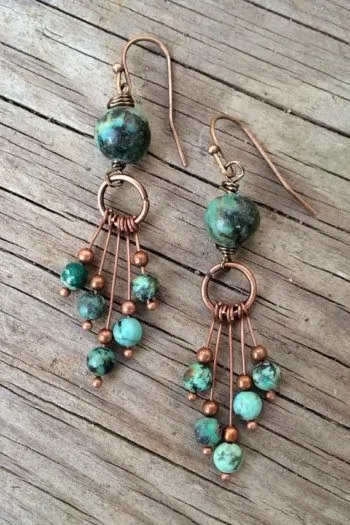Poison Ivy is a plant that is found in many parts of the world and can be easily identified by its clusters of leaves with 3 points. The plant contains a variety of toxic oils which can cause severe allergic reactions resulting in itching, swelling, and rashes and should never be touched by bare skin.
Unfortunately, these oils may sometimes stick to jewelry that has been exposed, so it is important to understand how to safely clean poison ivy off jewelry.
Cleaning Process: Outline the Steps Involved in Cleaning Jewelry Touched by Poison Ivy
Cleaning off poison ivy from jewelry needs to be done carefully as certain solvents and cleaning products can damage some metals and other materials. The best way to clean any type of jewelry is to use warm water and soap. Start by washing the piece in lukewarm water using a mild soap or dish detergent.
You should also use a soft bristled brush or toothbrush if necessary to help scrub away any dirt or debris that has accumulated on the item. If there are still stubborn stains then you can use some vinegar or baking soda mixed with water for spot-cleaning before rinsing it well and drying off with a towel.
Safety Concerns: Considerations When Wearing Jewelry That Has Been Exposed
It is not recommended to wear jewelry until it has been completely cleaned and dried off as any residual oils could trigger an allergic reaction when your skin comes into contact with them. It is also advisable not to have any exposed jewelry items come in contact with your eyes or mouth after being exposed as this could lead to serious health repercussions.
It is important for people who are sensitive to plants like poison ivy or sumac to be extra cautious when wearing any kind of jewelry as they may unknowingly carry invisible traces of these allergens that could transfer onto their skin while wearing them.
Supplies Necessary to Clean Poison Ivy Off Jewelry
When it comes to cleaning poison ivy off jewelry, the correct precautions must be taken in order to prevent an outbreak of rashes and suffering. First and foremost, you will need gloves – preferably rubber-soled ones, so as not to accidentally spread any additional oils from the plant onto your hands.
Additionally, you will need a brush with stiff bristles and some mild soap – like dishwashing detergent or a mild plant-based one. Finally, once the pieces of jewelry are clean, it is advisable to rinse them with cool water.
The first step in successfully removing poison ivy from your jewelry is to wear properly fitted rubber gloves and a long-sleeve shirt. This will help protect your skin against any additional contact with the oils from the plant. Next, wet the jewelry in cool running water and then brush it gently but firmly with a bristled brush.
Make sure not to scrub too hard as this can damage some materials such as stones or glittering finishes found on metals. Gently lather up your cleaning solution (mild soap) and rub it onto each piece of jewelry until all of the sap has been removed – don’t forget hidden areas like clasps.
Once all areas have been washed and scrubbed using a brush, rinse thoroughly using cool water until all soap residue has been removed. It is important that you avoid hot water during this stage as high temperatures can accidentally set oily residues from the ivy on platinum or gold pieces of jewelry making removal almost impossible no matter how hard you scrub.
After rinsing for about 10 minutes or so check again for any remaining residue or discoloration before patting dry with a towel or air drying by placing them on a cloth for about 24 hours if possible.
Procedure For Safely Cleaning Poison Ivy Off Jewelry
When it comes to cleaning poison ivy from jewelry, there are a few steps one must adhere to in order to do so safely and avoid the sticky itch that can come with poison ivy. If you have been exposed to the toxic vines, the first step is to wash your hands in soapy warm water for at least 15 minutes and scrub them vigorously with an abrasive.
This will help get any oils or toxins off of your skin before you start to work on your jewelry.
After washing and drying your hands, it is important to protect yourself further by wearing protective gloves while handling the jewelry. Gloves will prevent any potential oils from getting onto the metal or gems of the piece. It is also a good idea to place a towel under the items while they’re being cleaned. The key element when cleaning is using proper sterilized materials or fingerless, disposable latex gloves when cleaning each piece of jewelry.
The best way to clean poison ivy off of jewelry is by saturating a cotton swab with rubbing alcohol and carefully wiping away any residue from the surface. Be sure that as much as possible has been taken off before drying each item with paper towels or soft cloths, such as microfiber towels specifically designed for use on precious metals like gold or silver.
Lastly, do not forget to remove gloves once finished and discard them properly after each use, this reduces any chance of restarting the cycle of exposure again.
Once you have successfully removed all traces of poison ivy from your jewelry, it is important that these pieces are stored in an airtight container away from areas where they could accidentally be exposed again – like wild vegetation or heavily-wooded areas.
Additionally, ensure that they are clearly labeled if sharing with another person who may not be aware of what kind of material is contained within the box since unwitting contact may reinfect items even after proper removal has occurred priorly.
Tips For Wearing Jewelry When in Areas Where Poison Ivy Grows
When spending time outdoors in an area where poison ivy grows, it’s important to be mindful of potential contact with the poisonous plant. This is especially true if you plan to wear jewelry. If your jewelry becomes exposed to poison ivy and gets transferred onto your skin, the results can be unpleasant.
To help protect yourself from the dangerous effects of poison ivy, there are a few precautions you should take with regard to your jewelry. Never wear bracelets or necklaces as these are more likely to brush up against plants while you’re outdoors. If you choose to wear earrings, opt for studs that won’t swing around and can keep a good distance away from any vegetation.
If despite these precautions you happen to get poison ivy on your jewelry, don’t panic; it can still be cleaned off. To start, use hot soapy water and a soft cloth on metal surfaces like sterling silver or gold-plated items. Alternatively white or apple cider vinegar dabbed on the affected area will help dissolve the oily resin secreted by poison ivy plants.
Use caution when applying either option as some metals may be damaged due to chemical interaction between vinegar/soap and jewellery plating (i.e gold-plated). A solution of 70% rubbing alcohol is another great option for disinfecting jewelry contaminated with poison ivy, although it should not be used on gemstones since strong alcohols can erode away at softer crystals over time due to its composition being a solvent rather than an absorber.
Finally, after cleaning make sure all residue is gone before storing or wearing you jewellery again. To sanitize items further add some baking soda into a container filled with lukewarm water and stir until dissolved before soaking the piece in it for 15-30 minutes thereafter rinsing thoroughly with hot water and allowing it to air dry completely before storing away safely or wearing them out again in less hazardous areas.
How to Get Professional Care For Poison Ivy Rashes
When exposed to poison ivy, the best course of action is to act quickly. It’s important to wash off the area that has come into contact with the plant as soon as possible.
If it’s been a while since exposure, there may still be traces of oil on a person’s jewelry that can cause further exposure to the rashes. People who are prone to severe reactions or exposure over a large surface area should think about seeking professional medical care for their rash.
Professional medical help for treating a poison ivy rash is available through clinics and hospitals across the country. For example, depending on severity and other factors, physicians may prescribe medications or creams that can short circuit further irritation from additional exposure or from scratching the skin too much.
Rashes in more difficult-to-treat areas such as faces and genitals might require special attention and expertise offered by dermatologists. Additionally, treatments like immunotherapy and oral medications designed to reduce itching and swelling may be utilized depending on needs.
To prevent further spread of toxin onto clothing or jewelry, it’s also important to properly clean affected jewels-it can be tricky due to their intricate designs. There’s not one general solution that works best for all kinds of materials, but generally speaking it is necessary to first identify what kind of material needs cleaning and then go through some trial and error steps until you find out which approach works best with no damage done.
For most precious jewels specifically made of silver, gold or platinum you will want to pair gentle soaps with soft cloths and use imperceptible motions when cleaning instead of vigorous scrubbing or brushing motions. On top of periodic deep cleans, it may also help in preventing further contamination if once daily cloth passage with warm water is done on your jewelry items in order to remove built up oils from them over a period of time.
Overview of Products Available to Reduce Risks of Poison Ivy Exposure
When it comes to cleaning jewelry that has been exposed to poison ivy, the process can be a bit tricky. Therefore, it is important to understand all of the products available to reduce risks of exposure. Some companies manufacture specially formulated jewelry cleaning products that are specifically designed to get rid of poison ivy on jewelry quickly and safely.
These products contain specialized ingredients such as surfactants and mild detergents which gently clean surfaces while also breaking down oils left behind by poison ivy. Many of these products are colorless and odorless, making them perfect for use in sensitive areas such as diamond rings or necklaces with gemstones.
Another highly effective option is the use of alcohol-based cleaners. Alcohol-based jewelry cleaners not only make short work of any trace amounts of poison ivy found on your pieces but also make them shine like new once again.
This is because alcohol helps lift away oils and dirt from the surface which ultimately means a cleaner appearance along with lesser chances for irritation or infection from contact with poison ivy residue. In addition, many versions come in handy spray bottles or wipes so usage is quite convenient and easy.
Finally, some people may opt for using natural remedies for cleaning their jewels who have been exposed to poison ivy. One common method involves creating a paste using baking soda and water before scrubbing onto the affected areas with a soft cloth.
Vinegar or lemon juice mixed together with salt can also help break down stubborn oils left behind by poison ivy while also sanitizing the surface area where contact had occurred. Regardless of the type chosen, it’s important to understand how each product works in order to gain optimal results when attempting this type of clean-up task.
Tips on How to Clean Jewelry After Exposure
When handling poison ivy, it is important to take precautions to prevent any contact with the plant. Unfortunately, contact with the plant can occur accidentally, leaving jewelry exposed to oils from the plant and causing an irritating rash. Cleaning jewelry that has been exposed to poison ivy is important for preventing further irritation and spreading of the oils. Below are some tips on how to effectively and safely clean jewelry after exposure.
The first step in cleaning your jewelry is to fill a bowl or sink with warm, soapy water. Use a mild dish soap as harsh detergents may potentially damage fine jewelry or gemstones.
Immerse the contaminated item completely in the water for 15-20 minutes, or according to instructions from a trusted jeweler (if available). After soaking for at least 15 minutes, use a soft brush, such as a toothbrush, to gently scrub away all residues of the plant’s oil on each piece of your jewelry’s surface.
Once you have finished scrubbing away all visible oil residue, it is time to rinse off your cleaned pieces using cold running water. Be sure to properly rinse all surfaces of every piece of your jewelry thoroughly until all signs of soap have disappeared and no further suds appear when rinsing.
Dry each piece carefully using a soft cloth before finally inspecting the item for any remaining oils that may require an additional cleaning cycle before you can store them safely in their original location without worry.
It is essential that once you have completed this process you must dispose of used dishes and scrub brushes immediately as they could harbor toxic particles. Consider wearing disposable gloves when cleaning pearl or stones will absorb chemicals or delicate items if not handled correctly which may cause discoloration or damage.
Lastly for extra protection against future poisoning consider washing hands afterwards with rubbing alcohol followed by soap; avoid touching the eyes after direct contact with poison ivy oils as much as possible until adequate showering has taken place.
Creative Solutions For Keeping Jewelry Safe
If you love spending time outdoors, chances are at some point you have encountered poison ivy or poison oak. These plants can spread an irritating rash and unfortunately, if their nasty oils rub off on your jewelry pieces, it can affect anyone who touches it afterwards.
If you have ever experienced this issue before, you know that regular soap and water just won’t cut it. What are the best methods for cleaning jewelry that has been exposed to these potent plants?
The first solution is to use a mild bleach solution. You can create a mixture of one-part bleach and ten parts water in a small bowl and mix until evenly combined. Soak the affected area of your jewelry in this solution for 5 minutes and then rinse thoroughly with lukewarm water. Keep in mind that bleach should never be used on porous materials.
Another way to clean poison ivy off your jewelry is with vinegar and bicarbonate of soda. This combination forms a powerful natural cleaner that will help eliminate any residue that may be left behind from the plant oils.
Mix 1 tablespoon of bicarbonate of soda with 2 tablespoons of vinegar until they become a paste then gently scrub the affected area with this mixture using an old toothbrush or soft cloth. Rinse off with lukewarm water when done and dry completely with a soft towel before wearing again.
Finally, baking soda is another great option for removing any sticky residue from poison ivy or oak oils that may be left behind on your jewelry pieces. All you need to do is sprinkle some baking soda over the contaminated area and rub gently with a soft cloth until cleansed away completely before washing as normal. Baking soda helps absorb any lingering oils or residue, leaving your ring sparkling again without causing anymore irritation.
In conclusion, if you find yourself in contact with poisonous plants like poison ivy or oak, knowing how to properly clean your jewelry afterwards will save you from infections or other complications later down the road. Follow these simple steps such as using household ingredients like vinegar, bicarbonate of soda(baking soda), and mild bleaching solutions where necessary – all which should work effectively in solving this problem quickly.
Conclusion
Coming in contact with poison ivy can cause a very uncomfortable and itchy rash. Additionally, when not properly handled, the oil from poison ivy can easily spread to objects in your environment including jewelry. To remove any lingering oil and ensure that the skin does not come into contact with it again, it is critical to clean any affected jewelry.
The first step to clean poison ivy off of jewelry is to create a mixture of detergent and warm water. The most effective way to do this is by combining an equal ratio of dish detergent and water in a container or bowl before inserting the affected jewelry piece(s). Once all items are submerged, let them sit undisturbed for 1-2 hours before removing them and rinsing them off with cold water.
After they have been rinsed off, the item should be dried using a paper towel or cloth followed by leaving them on a towel overnight or allowing it to air dry for few hours. This step ensures that no residue remains on the item which could potentially cause an allergic reaction when wearing it. If possible, you should also wear rubber gloves during this process as well in order to avoid direct exposure to potential irritants from the oil.
Overall, cleaning poison ivy off jewelry will require some patience and caution but it still possible if done safely and accurately. It’s important to always keep an eye on any exposed areas of your skin when taking these steps so that you can provide immediate medical attention if necessary.
Also remember that if these DIY methods don’t produce successful results then seek help from professional jewelers as soon as you can in order to ensure maximum safety for yourself and others around you.

Welcome to my jewelry blog! My name is Sarah and I am the owner of this blog.
I love making jewelry and sharing my creations with others.
So whether you’re someone who loves wearing jewelry yourself or simply enjoys learning about it, be sure to check out my blog for insightful posts on everything related to this exciting topic!





